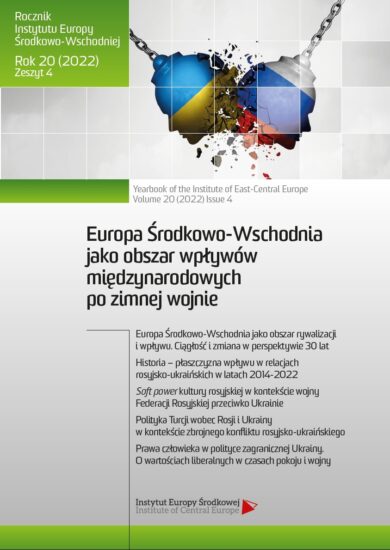Central and Eastern Europe as an area of rivalry and influence. Continuity and change in a 30-year perspective
ORCID: Agata Włodkowska: 0000-0002-7676-0693
Afiliacja: Akademia Finansów i Biznesu Vistula
Pages: 9-21
Edition: Lublin 2022
DOI: https://doi.org/10.36874/RIESW.2022.4.1
Citation method: A. Włodkowska, Europa Środkowo-Wschodnia jako obszar rywalizacji i wpływu. Ciągłość i zmiana w perspektywie 30 lat, „Rocznik Instytutu Europy Środkowo-Wschodniej” 20 (2022), z. 4, s. 9-21, DOI: https://doi.org/10.36874/RIESW.2022.4.1
Keywords: Belarus, China, conflict of interests, European Union, Moldova, NATO, rivalry, Russia, Turkey, U.S., Ukraine
Abstract:
Despite the three decades that have passed since the collapse of the USSR, the rivalry in the post-Soviet area continues. It is also going on in Central and Eastern Europe. Russia’s annexation of Crimea in 2014, followed by the Russian Federation’s open invasion of Ukraine eight years later, indicates that the intensity of the rivalry has intensified. The purpose of the article is to identify elements of continuity and change in this rivalry and to answer questions about the causes and prospects of the competition between states and non-state actors in the area. No less important is the question of whether the involvement of the superpowers in Central and Eastern Europe should still be considered a rivalry or rather a conflict. Elements of continuity can be found, among other things, in the involvement of the same actors, the reasons for involvement, and the persistence or even strengthening of conflicting interests. Also, some of the means and methods used remain the same. Among the elements of change are the unprecedented unity of the West and the increase in EU activity in the military sphere, the reduction of Russia’s ability to use some of its means and methods, and the loss of some of the advantages it had until recently.
Bibliography:
Bryjka F., Wojny zastępcze – próba konceptualizacji, „Sprawy Międzynarodowe”, t. 72, 2019, nr 4, http://doi.org/10.35757/SM.2019.72.4.08.
Colaresi M.P., Rasler K., Thompson W.R., Strategic Rivalries in World Politics. Position, Space and Conflict Escalation, Cambridge University Press, 2007.
Goertz G., Diehl P.F., The Initiation and Termination of Enduring Rivalries: The Impact of Political Shocks, „American Journal of Political Science”, vol. 39, 1995.
Goertz G., Jones B., Diehl P.F., Maintenance Processes in International Rivalries, „The Journal of Conflict Resolution”, vol. 49, 2005, no. 5.
Indieks położenija russkogo jazyka w mirie. 30 let Sodrużestwu Niezawisimych Gosudarstw, Gosudarstwiennyj i institut russkogo jazyka im. A.S. Puszkina, Moskwa 2022, https://www.pushkin.institute/news/index_2022.pdf.
Klein J.P., Goertz G., Diehl P.F., The New Rivalry Dataset: Procedures and Patterns, „Journal of Peace Research”, vol. 43, 2006, no. 3.
Knox O., Anders C., Why Ukraine isn’t a ‘proxy war’ (yet?), „The Washington Post”, 03.05.2022, https://www.washingtonpost.com/politics/2022/05/03/why-ukraine-isnt-proxy-war-yet/.
Legucka A., Kupiecki R., Disinformation, Narratives and Memory Politics in Russia and Belarus, London 2022.
Sevastopulo D., Russia has asked China for military help in Ukraine, US officials say, „Financial Times”, 14.03.2022, https://www.ft.com/content/30850470-8c8c-4b53-aa39-01497064a7b7.
Strachota K., Tureckie dylematy w cieniu wojny na Ukrainie, „Komentarze OSW”, 01.07.2022, https://www.osw.waw.pl/pl/publikacje/komentarze-osw/2022-07-01/tureckie-dylematy-w-cieniu-wojny-na-ukrainie.
Thompson W.R., Identifying Rivals and Rivalries in World Politics, „International Studies Quarterly”, vol. 45, 2000.
Włodkowska-Bagan A., Rywalizacja mocarstw na obszarze poradzieckim, Warszawa 2013.

PDF: Download